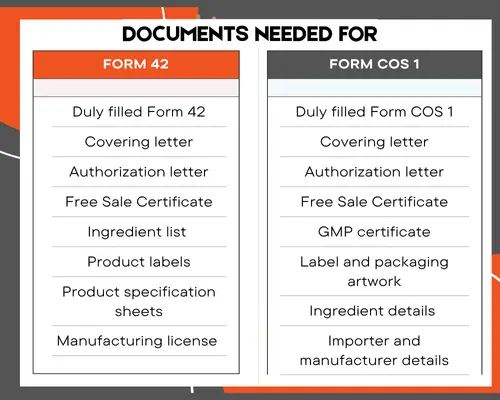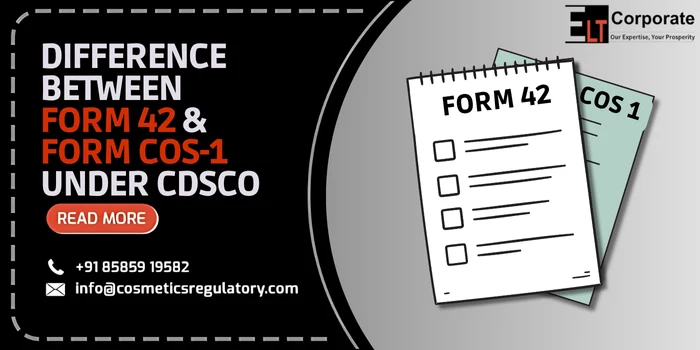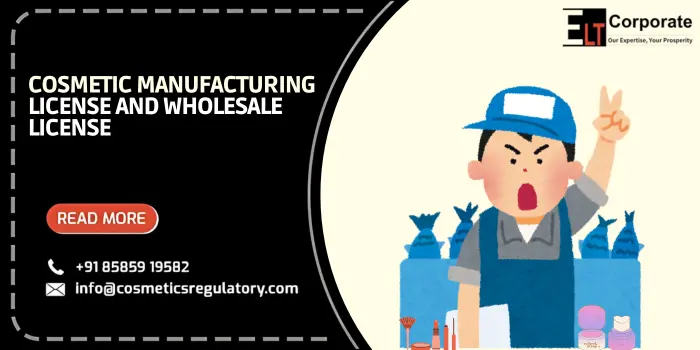To navigate the Indian cosmetics industry, it is essential to have a clearer understanding of the pattern utilized by the CDSCO. Cosmetic manufacturers and importers are facing confusion from the two major forms: Form 42 & Form COS 1. Both are connected to cosmetic registration and importation, but the two forms serve vastly different purposes and have different regulatory origins.
This article will explain the difference between Form 42 and Form COS 1, defining where and when to use each form and which form is acceptable now as per CDSCO guidelines.
What Are Form 42 and Form COS 1?
Prior to discussing the variations, let us see what Form 42 and Form COS 1 are and how they end up in the regulatory picture.
What Is Form 42?
Form 42 was mainly used for cosmetics registration under the Drugs and Cosmetics Act and Rules, 1945. If Form 42 is accepted by the CDSCO, in the case that all cosmetic products were registered under an agent or inquire importer documentation which had been issued by an agent with a license by the CDSCO, a Registration Certificate would be issued by the CDSCO in Form 43. This verifies that the listed cosmetic products are now able to be imported into India.
What Is Form Cos 1?
Form COS 1 is the new application form under the Cosmetic Rules, 2020, which replaced previous regulations. It is now the default to use for applying for an import license for cosmetics in India. When CDSCO approves this form, it releases Form COS 2 as the original import
Key Difference Between Form 42 and Form COS 1
To make it easier to understand, here’s a comparison table that outlines the difference between Form 42 and Form COS 1:
| Feature | Form 42 | Form COS 1 |
| Governing Rule | Drugs and Cosmetics Rules, 1945 | Cosmetic Rules, 2020 |
| Purpose | Cosmetic product registration | Cosmetic import license |
| Result of Application | Registration Certificate (Form 43) | Import License (Form COS 2) |
| Who Can Apply | Authorized Indian Agent or Importer | Authorized Indian Agent or Importer |
| Applicability | For applications before 2020 | Mandatory for all new applications |
| Current Use | Limited legacy cases | Standard and current legal requirements |
Required Documents for Form 42 and Form COS 1
While both forms aim at legalizing the import of cosmetics, the documents required can differ slightly.
Documents for Form 42 Application
- Duly filled Form 42
- Covering letter from the Indian agent
- Power of Attorney from a foreign manufacturer
- Free Sale Certificate
- Ingredient list and composition
- Product labels and artworks
- Product specification sheets
- Manufacturing license (from the country of origin)
Documents for Form COS 1 Application
- Duly filled Form COS 1
- A covering letter mentioning product details
- Power of Attorney or authorization letter
- Product Information File (PIF)
- Free Sale Certificate from the competent authority
- GMP certificate of the manufacturer
- Label and packaging artwork
- Ingredient details with percentage composition
- Importer and manufacturer details
Application Process Using Form 42 and Form COS 1
The application procedure for both forms can seem similar, whereas the few steps can be .
Form 42:
- Register on the SUGAM portal as an importer or Indian agent.
- Fill in Form 42 online.
- Upload the required documents in the specified formats.
- Pay the government fee via the portal.
- Wait for CDSCO to review and issue Form 43, the Registration Certificate.
Form COS 1
- Log in to the CDSCO’s SUGAM portal.
- Select “Cosmetics Import” registration.
- Fill out the Form COS 1.
- Attach required documents such as FSC, GMP, and PIF.
- Apply with a fee payment.
- Upon approval, receive Form COS 2 (Import License).

When To Use Form 42 And Form COS 1?
Being aware of when to utilize Form 42 and Form COS 1 is essential to remain in compliance:
- Use Form 42 only if your application was commenced before the Cosmetic Rules, 2020, being brought into operation. It is usually no longer accepted for new registrations.
- Utilize Form COS 1 for every new cosmetic import license application. It is the form that is officially accepted under the present regulations.
Conclusion
All stakeholders in India’s import of cosmetics must be aware of the difference between Form 42 and Form COS 1. Whereas previously, according to norms, Form 42 was the norm, Cosmetic Rules, 2020 have now made Form COS 1 the mandatory and streamlined process for the import of cosmetics in India.
With the aid of consultants like ELT, your application process can become easily manageable, compliant, and successful. We can assist you in bringing your cosmetic products to the growing Indian market safely, legally, and effectively.
FAQ’s
1. How are Form 42 and Form COS 1 primarily different from each other?
Form 42 was used for product registration under the previous rules, while Form COS 1 is used to obtain an import license under the new Cosm-–etic Rules, 2020.
2. Can I still apply using Form 42?
Form 42 is no longer accepted for new applications in general. You must apply using Form COS 1 under the new guidelines.
3. What license is granted after approval of Form COS 1?
Upon approval by CDSCO of Form COS 1, you are granted an Import License in the form of Form COS 2, allowing you to import and market cosmetics in India.
4. Who can apply on Form COS 1?
Only an Indian approved agent or Indian importer, acting on behalf of a foreign maker, can submit Form COS 1.
5. Does ELT permit submission of Form COS 1?
Yes. ELT provides complete regulatory support, including documentation, application filing, and coordination with CDSCO for Form COS 1 and other licensing needs.



